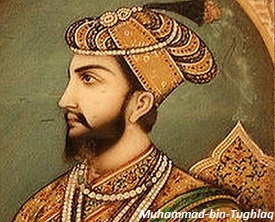
- Medieval Indian History Tutorial
- Medieval Indian History - Home
- Kingdoms of North India
- The Rajputs
- The Invaders
- Delhi Sultanate
- The Khilji Sultans
- Tughlaq Sultans
- Lodi Sultans
- New Kingdoms
- Religion
- The Sikh Movement
- Babur’s Advent into India
- Major Battles
- Significance of Babur's Conquest
- Humayun’s Conquest
- Humayun’s Downfall
- Sur Empire
- Akbar the Great
- Early Phase of Akbar’s Reign
- Expansion of Mughal Empire
- Akbar’s Administrative System
- Akbar’s Organization of Government
- Akbar’s Relation with Neighbours
- Rebels during Mughal Empire
- Deccan & South India
- Conquest of South – I
- Conquest of South – II
- Deccan’s Cultural Contribution
- Political Development Mughals
- Nur Jahan
- Shah Jahan’s Rebel
- Mughals’ Foreign Policy
- Mansabdari System
- Social Life under the Mughals
- Nobles & Zamindars
- Trade & Commerce
- Mughals’ Cultural Developments
- Language, Literature & Music
- Religious Ideas & Beliefs
- Problems of Succession
- Aurangzeb’s Reign & Religious Policy
- North-East India
- Popular Revolts & Movements
- Rise of Maratha
- Administrative System of Shivaji
- Aurangzeb & Deccani States
- Reference and Disclaimer
Medieval Indian History - Tughlaq Sultans
Tughlaq dynasty came after the Khilji dynasty and ruled from A.D. 1320 to 1413.
Tughlaq Dynasty (1320 – 1413)
In 1,320, Ghazi Malik became the king under the title of Ghiyath al-Din Tughlaq. Likewise, the ‘Tughlaq’ dynasty began.
Muhammad-bin-Tughlaq
Muhammad-bin-Tughlaq (1325-51), the eldest son and successor of Ghiyath al-Din Tughlaq, was one of the most ambitious and powerful Sultans of Tughlaq dynasty.

Ibn Battutah, the North African Arab traveler, came India during Muhammad-bin-Tughlaq’s period and he had written the detailed description of the Muhammad’s kingdom.
Muhammad was a man of ideals who attempted as far as possible, to rule on the principles of reason. He was a great knowledgeable mathematician and a logician.
Muhammad increased the taxes of the peasants (especially who were from the Doab area). However, a famine in the Doab region made condition worse.
As a result of famine, the people refused to pay the extra taxes and rose in rebellion; therefore, finally, the Sultan had to cancel his order.
Muhammad also moved the capital from Delhi to Devagiri (which he renamed Daulatabad). As per his strategic plan, Daulatabad (located nearby modern Aurangabad in Maharashtra) was a better place for controlling the Deccan.
The moving of the capital was, however, not successful, as it was too far from northern India, and hence, the Sultan could not keep a watch on the northern frontiers. Therefore, Muhammad returned the capital back to Delhi.
Muhammad decided to issue 'token' coins on brass and copper, which could be exchanged for silver coins from the treasury. This scheme would have worked, if he had monitored it carefully and allowed strictly only to the government body to issue token coins. But it did not happen rather many people started making brass and copper ‘tokens’ and the Sultan, therefore, had no control over the finances. The token coins had to be withdrawn.
Unfortunately, Muhammad’s many administrative policies failed; hence, gradually he lost the support not only of the people, but also many of the nobles and the ulema.
The ulema were the scholars of Islamic learning who were generally orthodox in their outlook.
Firoz Shah Tughlaq
In March, 1351, Muhammad died. After his death, his cousin Firoz Shah came to the throne who ruled till 1388.

Firoz realized that one of the reasons for the failure of Muhammad was that he did not have the support of the nobles. Therefore, Firoz first established a friendly relation with them and made them happy by giving them, grants or revenue.
Firoz, further, allowed the orthodox ulema to influence state policy in certain matters. Thus Firoz improved his relationship with the powerful groups at the court; however, in spite of all these, the power of the Sultan decreased.
In the meantime, the governors of certain provinces, including Bihar and Bengal, had rebelled against the Sultanate. Firoz tried to control them, but was not very successful.
Firoz was interested in improving the general welfare of his subjects. He improved parts of the kingdom by starting new irrigation schemes. The Yamuna Canal was one of his schemes.
Firoz also established a few new towns, such as Ferozpur, Ferozabad, Hissar-Firoza, and Jaunpur.
Firoz also constructed many educational centers and hospitals. He was interested in the ancient culture of India. Firoz order to translate a number of Sanskrit books into Persian and Arabic languages.
Firoz also owned two of the pillars of the emperor Ashoka and one of them was placed on the roof of his palace.
In September 1388, Firoz died, after which there was a civil war among his descendants. Because of the political instability, the governors of many provinces became independent kings and finally only a small area around Delhi remained in the hands of the Tughluq Sultans.
Sayyid Dynasty (1413 – 1451)
By 1413, the Tughlaq dynasty ended completely and local governor occupied Delhi and given way to Sayyid Dynasty.
In 1398, Timur, the Turkish chief invaded India and robbed Indian wealth. While returning back, he appointed Khizr Khan as the governor of Delhi.
Khizr Khan had taken Delhi from Daulat Khan Lodi and founded Sayyid dynasty in 1414. Sayyid dynasty ruled Delhi until 1451.
In 1421, Khizr Khan died, hence, his son Mubarrak Khan succeeded. Mubarrak Khan represented himself as ‘Muizz-ud-Din Mubarak Shah’ on his coins.
Mubarrak Khan ruled till 1434 and he was succeeded by his nephew Muhammad Shah. Muhammad Shah ruled till 1445.
Muhammad succeeded by Ala-ud-din Alam Sham, who ruled till 1451. In 1451, Bahlul Lodi became the Sultan and founded the Lodi dynasty.